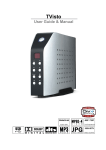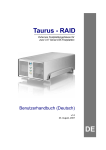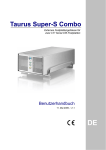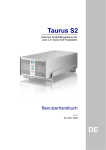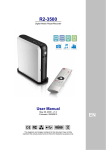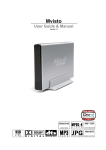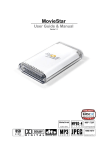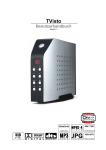Download Macpower D7-3500 User manual
Transcript
D7-3500 User Manual & Installation Guide October 15, 2007 v1.1 D7-3500 User Guide Table of Contents CHAPTER 1 - INTRODUCTION CHAPTER 2 - SYSTEM SETUP 5 HDD INSTALLATION 5 7 1 THE D7-3500 1 INSTALLATION OF THE WIRELESS KIT PACKAGE CONTENTS 1 TV SETUP 10 SYSTEM REQUIREMENTS 1 SETUP MENU 11 PC REQUIREMENTS 1 OPTIONS 11 TV REQUIREMENTS 1 [SCREENSAVER] 11 INTERFACE INFORMATION 2 [LANGUAGE] 11 REMOTE CONTROL 3 [SLIDESHOW] 11 [CLEAR] 3 [INTERNET] 11 [SELECT] 3 [VIDEO] 11 [TV MODE] 3 [AUDIO] 11 [SETUP] 3 [BROWSER OPTION] 11 [VOLUME] 3 [SOUND OPTION] 11 [MENU] 3 IP CONFIG 12 [RETURN] 3 [MAC ADDRESS] 12 [A-B] 4 [IP ADDRESS] 12 [REPEAT] 4 [SUBNET MASK] 12 [INFO] 4 [PRIMARY DNS] 12 [EDIT/PROGRAMM] 4 [SECONDARY DNS] 12 [SHUFFLE] 4 [DEFAULT GATEWAY] 12 [SUBTITLE] 4 [AOL] 12 [AUDIO] 4 WIRELESS SETUP 13 [ZOOM] 4 [PREFERRED] 13 [AVAILABLE NETWORK] 13 [SSID] 13 [CONNECTION] 13 [SECURITY] 13 [KEY] 13 TIME SETUP 14 UPDATE ROM 14 D7-3500 CHAPTER 3 – USB CONNECTION User Guide CHAPTER 5 - APPENDIX 20 SPECIFICATIONS 20 15 INTERNAL HDD 15 FAQ 21 INSTALLATION ON A PC 16 REMOTE CONTROL KEY FUNCTIONS 22 FORMATTING 16 ABOUT THIS MANUAL 23 REMOVAL PROCEDURE 16 USB HOST 17 CHAPTER 4 – NETWORK MODE 18 UPNP DEVICES 18 MEDIA SERVER 18 ONLINE PREMIUM CONTENT 19 [VTUNER] 19 [AOL] 19 [INTERNET TV] 19 [MUSIC] 19 [PHOTO] 19 [NEWS] 19 [ENTERTAINMENT] 19 [TECHNOLOGY] 19 [SEARCH] 19 [EDIT] 19 D7-3500 User Guide Chapter 1 - Introduction The D7-3500 The 'D7-3500' Digital Media Adapter is the perfect gateway for your living room, linking up your PC, TV, stereo, digital camera and much more. Great design coupled with playback support for all kinds of standard media formats and simple installation makes it the perfect all-in-one multimedia solution. Product Dimensions: 16.5cm x 16.5 cm x 5.2 cm 6.50” x 6.50” x 2.05” Package Contents • D7-3500 • External Power Adapter; Input 100-240V, Output +12V/2A • Composite and Component video cable • SPDIF optical audio cable • Ethernet cable, SCART adapter • Infrared remote control • Manual, CD with MyHome application and user guide Note: Package content may vary, depending on vendor & version. System Requirements PC Requirements • Minimum Intel Processor III 500MHz, 128MB RAM • Operating System; Win98SE, WinME, Win2000, WinXP • USB 1.1 or USB 2.0 connection • 10 Mbps, 100 Mbps or 10/100Mbps Fast Ethernet card, or a USB-to-Ethernet converter equipped PC with CD-ROM TV Requirements • Video/Audio input, standard Composite RCA input • Optional Component input and amplifier for digital audio Note: To make use of all features the D7-3500 offers, an Ethernet connection with access to the local network and internet is required. Additionally, a computer running the MyHome media server is recommended. Page 1 / Chapter 1 - Introduction D7-3500 User Guide Interface Information Following images are for reference only and show the D7-3500 with the optional 802.11 b/g antenna. Green: USB connection Infrared Receiver Power receptacle Blue: Power ON/OFF Yellow: LAN connection USB device connector USB host connectors Power switch A/V output multi-interface SPDIF audio output Page 2 / Chapter 1 - Introduction Ethernet port D7-3500 User Guide Remote Control Power ON/OFF No Function Input for time, search, login, URL and other text. Input Selector Clear (Backspace) [CLEAR] Delete a letter or number when entering text. [SELECT] Toggle text input between upper case, lower case and numbers. No Function TV Mode Setup Volume Adjustment Mute Sound Navigation Keys Menu Return [TV MODE] Each time this button is pressed, the video output will change. Use this when you only see a blank screen but go to setup and save your settings once you have a signal. [SETUP] Press this key to enter the setup menu and change the settings and other configuration options for your D7-3500. [VOLUME] When browsing web pages, these keys can be used to scroll up and down, otherwise they are used to adjust the volume for music and video files. [MENU] Tab between the different menu options. [RETURN] Go one step back and return to the previous menu. Page 3 / Chapter 1 - Introduction D7-3500 User Guide A: N/A B: Return to Menu Playback Functions A: N/A B: Return to Home A: File Info B: Go to Setup A: Time Search B: URL input Audio output Subtitle encoding/OFF A: Repeat B: Refresh Zoom Function No function No function Rotate Images [A-B] Return to the menu or the main screen depending on the present mode. [REPEAT] Return to the main screen. [INFO] Go to the setup menu or show file info during playback. [EDIT/PROGRAMM] Go to URL or time search during playback. [SHUFFLE] Refresh screen or change repeat mode during playback. [SUBTITLE] Toggle between different encodings for the subtitles or turn them OFF. [AUDIO] Change between stereo and mono output. [ZOOM] Zoom mode for photos (press Enter in zoom mode to pan) and toggle between full screen, actual size and original size for movies. Note: See Appendix for detailed functions of each key. Page 4 / Chapter 1 - Introduction D7-3500 User Guide Chapter 2 - System Setup HDD Installation Your unit might come with an installed hard drive. Before opening such an enclosure, please read the warranty and any other notes from your vendor carefully, as this might void your warranty. 1. Lift the top cover off the body. If it’s already locked in place, push it upwards with a thin and small item through the opening at the bottom. 3. Lift the frame out of the plastic casing. 4. Align the screw threads of the hard drive with the holes in the framing and place it upside down in the frame. 2. Remove the screws which are holding the aluminium frame in place. Page 5 / Chapter 2 - System Setup D7-3500 User Guide 5. Place the metal sheet cover over the drive and align it with the holes of the framing. 7. Place the assembled drive back in the plastic framing, connect the cables and mount it on the heat sink by fastening the screws. 6. Fasten the screws from the side. 8. Align the top cover with the body and push lightly into place. Note: Be careful not to damage any cables or components during the installation! Page 6 / Chapter 2 - System Setup D7-3500 User Guide Installation of the Wireless Kit The D7-3500 is available as a wired or wireless model. If you own the wired model and have later purchased the wireless kit, see following instructions for the installation. Before opening the enclosure, please read the warranty and any other notes from your vendor carefully, as this might void your warranty. 1. Lift the top cover off the body. Push it upwards with a thin and small item through the opening at the bottom. 2. Remove the screws which are holding the aluminium frame in place. 3. Disconnect the cables, then lift the frame and the hard drive out of the plastic casing. 4. Remove the screws which are used to mount the bridge board to the heat sink and lift the board out of the casing. Page 7 / Chapter 2 - System Setup D7-3500 User Guide 5. Turn around the bridge board, insert the PCI module in the PCI slot on a slight angle and gently press down on the PCI module till the side clasps lock it into place. 6. Remove the plastic cap for the antenna opening. 7. Insert the antenna into the slot opening ensuring it is pointing upright and then place the lock on the internal end of the antenna to secure it to the unit. 8. Align the bridge board with the body and connect the antenna cable end to the “main” connector on the PCI module. Page 8 / Chapter 2 - System Setup D7-3500 User Guide 9. Fasten the screws to mount the bridge board to the heat sink. 11. Fasten the screws. 10. Place the assembled drive back in the plastic framing and connect the cables. 12. Align the top cover with the body and push lightly into place. Note: Be careful not to damage any cables or components during the installation! Remark: Only use the wireless kit designed for the D7-3500. We do not support 3rd party PCI cards and installation of any other components will void the warranty. Page 9 / Chapter 2 - System Setup D7-3500 User Guide TV Setup Find a suitable place for your D7-3500, within a distance of 1.2m or less of your TV screen. Connect the power supply and the power outlet. Included with your D7-3500 are a standard AV cable and a YPbPr cable. Connect it to the A/V connector on the D7-3500 and plug it into your TV. For the video, use either S-Video (better quality) or if not available, the yellow RCA connector. For analogue audio, use the white and red RCA connectors. If your TV supports it, we recommend using the component cable (YPbPr) for optimum video quality (up to 720p or 1080i) instead of the standard AV composite cable. For Dolby 5.1 surround and digital audio output, we recommend using the SPDIF optical audio cable. Connect this to your amplifier or sound system and change the settings for audio output on your D7-3500 to RAW format and 5.1 surround output. For content streaming from your computer and the internet, connect the LAN cable to an Ethernet switch or router. For the wireless model, content streaming is possible wirelessly using 802.11b or g. However, for optimum performance and high definition content with high bitrates, we recommend using the wired LAN connection option instead of the wireless setup. Having connected all cables, you are now ready to turn on the power and use the remote control to turn on the device. Simultaneously, turn on your television set, and select the A/V channel. Wait a few seconds for the system to boot and you should see the D7-3500 welcome screen. Note: If everything is setup correctly but you can not see the welcome screen, press the TV Mode button until you find the right video signal. Page 10 / Chapter 2 - System Setup D7-3500 User Guide Setup Menu Once booted, press the SETUP key on your D7-3500 remote control to access the configuration screen and its settings. Options [Screensaver] Set a time from 1-60 minutes before the screensaver turns on. [Language] Select your preferred language for the on-screen menu, file browser encoding and subtitles. You can also turn off the subtitles for your movies here. The default language is English. [Slideshow] Set the transition time and repeat mode for the slideshow presentation. [Internet] Options for internet security used to browse the web. By default this is set to SSL2, which will work fine for most purposes of the D7-3500. [Video] Select your video output and the preferred zoom level for watching movies. If you accidentally saved the wrong video output and only see a blank screen, press the TV Mode button until you see the screen again. [Audio] By default, the audio is set to analogue stereo audio. If you use digital audio or would like to change the default settings, change it here and save the new settings. [Browser Option] Enables HD mode for a more compact and smaller browser. [Sound Option] Turns the system alert or typing sound ON or OFF. Page 11 / Chapter 2 - System Setup D7-3500 User Guide IP Config By default, you can leave these settings and the D7-3500 will automatically request the IP and other information over the network. If the internet connection does not work or you would like to change it, switch to manual mode. Input an IP address from your local network which is not in use yet. Enter an IP for the subnet mask and the default gateway. For the DNS server, we recommend using two different IP’s, preferable from a local and reliable provider. [MAC Address] Displays hardware address to identify each unit [IP Address] Choose an IP address that is different from other computers, printers and various devices on your network but is part of the local network. [Subnet Mask] The most common setting for home networks is 255.255.255.0. [Primary DNS] The IP address of your Domain Name Server (DNS). [Secondary DNS] The IP address of your backup Domain Name Server (DNS). [Default Gateway] The IP address of the gateway or router on your local network. [AOL] Server and URL setup for AOL subscriber services. Note: To use direct internet access for IPTV, webradio, podcasts and other content, make sure to enter a valid DNS server. Numbers seen in the image above are for reference only and will be different to your settings. Page 12 / Chapter 2 - System Setup D7-3500 User Guide Wireless Setup To configure and use the wireless function, the optional antenna and mini PCI card have to be installed first. Set your preferred network to wireless and save the settings. You will be prompted to reboot. After restarting the system, go back to WIFI Setup, select your wireless network and configure connection type and security key if required. Save the settings and reboot once more. [Preferred] Set to Wired if you use the Ethernet cable or set to Wireless if you use the 802.11b/g wireless antenna to connect to the network. [Available Network] To use the wireless function, first set your preferred network to wireless, save the settings and reboot. After restart, it will automatically display the available access points (AP) and you can select your home network. To scan again for available AP’s, select WIFI setup and click Enter. [SSID] This field will be populated automatically once an available network has been selected. If the SSID is hidden, enter the name of your SSID manually. [Connection] Select your connection type. By default and for standard connections, this will be set to Infrastructure (AP) but if required, you also set it to Ad-Hoc (peer-to-peer). [Security] D7-3500 supports WEP 64-bit or 128-bit encryption for additional security. Select the WEP encryption used in your home network and enter the key or set it to OFF. [Key] If you are using WEP encryption for your wireless network, enter the WEP key here, otherwise leave this field empty. When 64-bit WEP is used, the WEP key should be 10 hexadecimal characters. If 128-bit WEP is used, the WEP key should be 26 hexadecimal characters. A valid value for a hexadecimal character is 0 to 9 and A to F. Page 13 / Chapter 2 - System Setup D7-3500 User Guide Time Setup Setup for clock time with time zone and NTP server. If the NTP server is set and an internet connection exists, the D7-3500 can synchronise the time automatically. The default value for the NTP server should work fine, so you only have to choose your time zone, turn on daylight saving if required and save the settings. Update ROM Displays current firmware version and can be used to check for new releases and upgrades for the D7-3500. If your D7-3500 is not connected to the internet, you can download the latest firmware and save it on a USB disk. Connect it to the USB port on your D7-3500 and browse for the update file, then manually update the firmware. Page 14 / Chapter 2 - System Setup D7-3500 User Guide Chapter 3 – USB Connection Internal HDD The D7-3500 was designed to house an internal hard drive for additional storage. When connected to the TV, the media files on the hard drive can be accessed and viewed. If there are more than 7 files in one folder, use the Volume +/- buttons to scroll up and down the list 9 files at a time. To scroll up and down file by file, use the UP and DOWN buttons instead. Press ENTER to play a single file or press PLAY to playback all the files in that particular folder. To update content on the internal drive, the D7-3500 must to be connected to your PC via USB. 1. Turn off the power and if you need to physically move the device, disconnect the audio and video cables. 2. Plug in the USB cable to the USB device port and connect it directly with your computer. 3. Turn on the power and access the drive under My Computer. 4. Once you have erased old and added new files, disconnect it from your computer and remove the USB cable. 5. Connect it back to your TV and turn on the power. Your new files can now be accessed on screen. Note: The data on the internal drive can not be accessed or updated via network connection. Page 15 / Chapter 3 - USB Connection D7-3500 User Guide Installation on a PC If the drive has been pre-installed and setup already, you do not need to prepare anything else and can use it straight away. If you have installed the drive yourself and this is a brand new HDD, you will have to create a partition first and format the drive before it can be used. 1. 2. 3. 4. Turn on your computer and start Windows. Connect the D7-3500 via USB and turn it on. Let Windows search and install the driver automatically. Open “My Computer” to see your external hard drive. Formatting For the D7-3500 to be able and access the data on the internal drive, it has to be formatted using FAT32. 1. Start the device manager, select the USB drive and create a single primary partition. 2. Format it using FAT32. The drive name you use here will be the name displayed on the TV. Note: To create FAT32 partitions larger than 32GB using WinXP, a third party application is required. Multiple FAT32 partitions will not be recognised by the D7-3500, so if you create more than one FAT32 partition, you will only be able to access the first on TV. None FAT32 partitions will not be recognised by the D7-3500. Removal Procedure For the safe removal of your drive and to assure that no data is lost, always follow the correct unplug procedure. Otherwise, an error message will appear. 1. Click on the taskbar icon for external hardware 2. Choose your external hard drive and confirm to remove it Page 16 / Chapter 3 - USB Connection D7-3500 User Guide USB Host The D7-3500 has two USB connectors for external USB devices. You can connect up to two USB mass storage devices with digital media content to display on your TV. For the D7-3500 to recognise the external USB device it has to be mass storage class, and the file format must be FAT12, FAT16 or FAT32. As an example, you may use a USB disk, an USB card reader or a USB memory stick. Simply plug in your USB device, turn on the power and you will be able to access the device from the main screen. Browse the content, select the files you like to see and press ENTER or PLAY to display them. Note: USB hubs are not supported and we recommend using self-powered USB drives. If two bus-powered USB drives are connected at the same time, at least one of them needs to be powered by an external power supply. If there are more than 7 files in one folder, use the Volume +/- buttons to scroll up and down the list 9 files at the time. To scroll up and down file by file, use the UP and DOWN buttons instead. Press ENTER to play a single file or press PLAY to playback all the files in that particular folder. Page 17 / Chapter 3 - USB Connection D7-3500 User Guide Chapter 4 – Network Mode There are 3 different kinds of network modes: • UPnP devices on local network • Media server on PC • Online premium content with direct internet access UPnP devices To access a Universal Plug and Play (UPnP) device, all you need to do is connect it to the same local network as your D7-3500. Turn on the UPnP enabled NAS or Windows Media Connect as an example and then turn on the D7-3500. On boot up, it will automatically connect to the network and list any compatible devices. Once mounted, you can access it from the main screen. For UPnP servers such as Windows Media Connect or other applications, make sure your firewall is setup properly; otherwise D7-3500 will not recognise the device. Media Server To use this mode, you need to install the included “MyHome” application or Windows Media Connect on your computer. Connect the computer to the same network as your D73500, start the application and you will be able to access your shared files from the computer directly on your D7-3500. To connect the D7-3500 to your computer without a local network, use a cross over Ethernet cable. To setup a new media server, go to the main screen. It should automatically detect new servers but if not, click on the add button. You will have to enter the name of your MyHome server and the IP address of that computer. Once it is setup, you can access the server from the main screen. For more details regarding the “MyHome” application and Windows Media Connect, please refer to the PDF manual on the included CD. Page 18 / Chapter 4 - Network Connection D7-3500 User Guide Online Premium Content In this mode, you can access content on the internet directly from your D7-3500, without the need to turn on any computer. To use this function, make sure your gateway and DNS server are setup properly and that you have access to the internet. [VTuner] Access to online radio broadcast and web radio with advanced search features. Bookmark your favourite channels and listen to music from all over the world right from your living room. [AOL] Access to AOL subscriber services. [Internet TV] View internet TV from all over the world. Sorted by countries, you can browse the available TV channels and select the one you like for broadcast. For optimum quality, high-speed internet access with good connection between TV server and your home is required. [Music] Listen to music news, web radio and podcast shows online. [Photo] Access web based photo services like Flickr and view your photos. [News] Read or listen to world news from ABC, BBC, CNN, Yahoo, MSNBC and others. [Entertainment] Watch video clips and podcast shows related to entertainment. [Technology] Watch podcast shows featuring the latest technology, gadgets, reviews and other news. [Search] Search the web by movies, podcasts, photos and other content using the Yahoo search engine. [Edit] Add your own bookmarks to your personal service portal or any other website. Page 19 / Chapter 4 - Network Connection D7-3500 User Guide Chapter 5 - Appendix For RMA and other questions, please contact your vendor or check out their online support area! Specifications Internal Storage Playback Formats 3.5” SATA-I or SATA-II HDD (1.5Gb/s or 3.0Gb/s) Video: • MPEG-1 up to 1.15Mbps CBR (MPG, MPE, MPEG, DAT, M1V) • MPEG-2 up to 15Mbps and 1080i (MPG, MPE, MPEG, M2V, VOB) • MPEG-4 up to 720p XviD, RMP4 (AVI, MOV, MP4) • WMV9 up to 720p (ASF, WMV) (online key authorisation not supported) • MOV: 3ivX + MP3, 3ivX + PCM (3ivX converted from supported MPEG-4 video codec using Dr. DivX 2 for Mac OS) • MP4: MP4V + MP4A (AAC) only support non-hinted MP4 • AVI audio codec: MP3, AC3, PCM, WMA, Ogg Subtitles: SUB (MicroDVD format), SRT (SubRIP format), SMI (SAMI format), SSA (Sub Station Alpha format), Embedded Multiple Subtitle support Audio: • MPEG-1 Layer 1 (MP1, MPA) • MPEG-1 Layer 2 (MP2) • MPEG-1 Layer 3 (MP3) • Ogg Vorbigs (OGG) • AC3 5.1 (AC3) • Microsoft PCM Wave (WAV) • Advance Audio Coding AAC, ADIF, ADTS (AAC) • Apple MPEG4 AAC Audio (M4A) • Microsoft Windows Media Audio version 1&2 (WMA, ASF) • Microsoft Windows Media Audio Professional WMA Pro (ASF) Photo: • JPG baseline and progressive up to 8 mega pixel • GIF • PNG Page 20 / Chapter 5 - Appendix D7-3500 Supported USB devices UPnP Version Output Interfaces User Guide Mass Storage class devices using FAT12, FAT16 or FAT32, including USB hard drives, card readers and USB memory sticks. v1.0 Video NTSC/PAL: • Composite Video • S-Video • Analogue Component Video up to 720p or 1080i • SCART RGB (optional cable) • VGA up to 1024x768 (optional cable) Audio: • Dual Stereo Analogue Audio • SPDIF optical output Power Supply External Power Adapter universal auto-switching (UL, cUL) Input: AC 100-240V, 1.2A, 50-60Hz Output: DC +12V/2A FAQ Q: My TV screen is blank and I can not see the D7-3500 main screen! A: Make sure the cables are connected firmly and the TV is set to the proper (A/V) channel. Turn on the D7-3500 and wait for about 10-20 seconds. If you still do not see anything, press the TV Mode button on your remote control to change the video output until you see the screen. Q: I can not access the internet! A: Make sure that the D7-3500 is connected to your network and that your internet security is setup properly. Press the SETUP key and confirm the IP configuration and DNS server. If the automatic function does not work, switch to manual mode and enter the IP addresses by yourself. To access the internet, the DNS server needs to be accurate and running. Q: My file names and bookmarks are scrambled! A: Go to the setup menu and change the encoding to your language. Q: Can I access the internal drive via network? A: No, the data on the internal hard drive can only be accessed via USB connection. Q: What file system does the D7-3500 support? A: For the D7-3500 to be able and access the data on the internal drive, it has to be formatted using FAT32. Page 21 / Chapter 5 - Appendix D7-3500 User Guide Remote Control Key Functions Item Button 1 Power 2 1 3 2 4 3 5 4 6 5 7 6 8 7 9 8 10 9 11 0 12 CLEAR 13 SELECT 14 TV MODE 15 SETUP 16 MUTE 17 VOLUME 18 UP 19 DOWN 20 LEFT 21 RIGHT 22 ENTER 23 RETURN 24 MENU 25 A-B 26 PREV 27 PLAY 28 NEXT 29 REPEAT 30 REV 31 STOP 32 FWD 33 INFO 34 SLOW REV 35 PAUSE/STEP 36 SLOW FWD 37 EDIT/PROGRAM 38 TITLE 39 SUBTITLE 40 AUDIO 41 SHUFFLE 42 ANGLE/ROTATE 43 SEARCH 44 ZOOM Browser Mode Power OFF 1 - .:/@ 2 - ABC 3 - DEF 4 - GHI 5 - JKL 6 - MNO 7 - PQRS 8 - TUV 9 - WXYZ 0 - Space Backspace Caps/Num Toggle video output Go to setup page Mute sound Scroll up/down Up Down Left Right Enter/Select Return to previous screen Tab (select next menu) Go to home Photo page (MyHome) Select icon Internet page (MyHome) Go to main screen Video page (MyHome) Stop download Music page (MyHome) Go to setup page N/A N/A N/A Go to URL N/A N/A N/A Refresh N/A N/A N/A Playback Mode Power OFF Go to 10% Go to 20% Go to 30% Go to 40% Go to 50% Go to 60% Go to 70% Go to 80% Go to 90% Go to 0% N/A N/A N/A Go to setup page Mute sound Volume +/Previous clip Next clip Rewind by % Forward by % N/A N/A N/A Go to home Previous clip Play Next clip N/A Rewind Stop playback Forward Display file info N/A Play/Pause Slow motion (MPEG) Go to by time search N/A Subtitle encoding or OFF Stereo/mono audio output Repeat mode Rotate photo N/A Zoom mode (movie/photo) Page 22 / Chapter 5 - Appendix D7-3500 User Guide About this Manual This manual was designed for the D7-3500 with wireless antenna. Images and descriptions may therefore slightly vary between this manual and the actual product you have. © Copyright 2007 by Macpower & Tytech Technology Co., Ltd. all Rights Reserved The information contained in this manual is believed to be accurate and reliable. Macpower & Tytech Technology assumes no responsibility for any errors contained in this manual and reserves the right to make changes in the specifications and/or design of this product without prior notice. The diagrams contained in this manual may also not fully represent the product that you are using and are there for illustration purposes only. Macpower & Tytech Technology assumes no responsibility for any differences between the product mentioned in this manual and the product you may have. Page 23 / Chapter 5 - Appendix



























